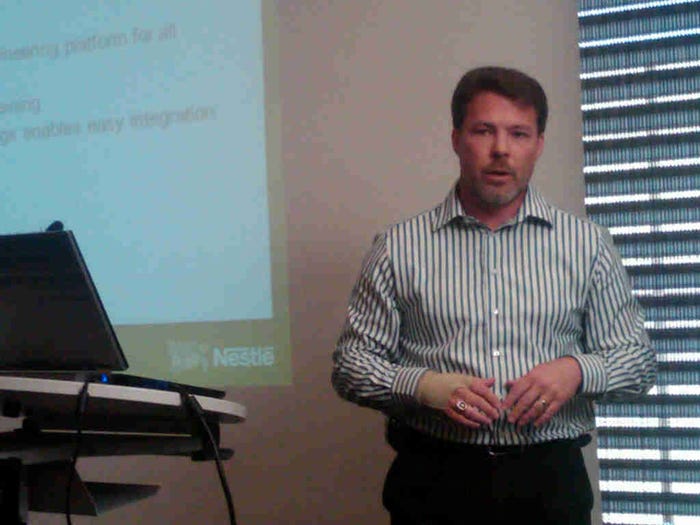March 11, 2015


Bryan Griffen Nestle
Düsseldorf, Germany - Interpack, the world's largest packaging trade show opened Thursday, May 12, 2011, with more than 4,000 exhibitors and more than 150,000 attendees expected to attend the week-long show.
Appropriately, one of the first press conferences of the show was presented by the Organization for Machine Automation and Control (OMAC), a global organization dedicated and implementation of open-control technologies for packaging manufacturing operations. In a show with exhibitors from all corners of the world speaking multiple languages, OMAC's stated goal of standardizing machine language for packaging operations rings loud and clear.
The OMAC press conference was highlighted by presenters from two major consumer packaged goods companies: Procter & Gamble and Nestlé. These industry giants are working with OMAC to develop PackML, which will simplify tasks such as packaging line integration, synchronization, data acquisition and overall equipment effectiveness. The two companies also are the early adopters of the standardized machine language.
Rob Aleksa, controls manager for Procter & Gamble, says his company is adopting use of PackML to increase the speed of their packaging lines, more easily gather packaging production data, increase reliability and make the packaging machinery easier to use for a diverse global workforce. He explains, PackML and Packtags allow faster start-up, more operational consistency and more consistent tools to manage manufacturing.
Aleksa also remarks that P&G sources packaging equipment from all over the world for installation in many countries. The CPG wants this equipment to work together in standard ways. Consequently, he says, P&G is asking larger original equipment manufacturers to use PackML in new equipment is buying. He pointed out benefits for OEMs, too, such as faster machine development, greater re-application of software code, platform independence and increased innovation in machine capability.
Bryan Griffen, OMAC Packaging Workgroup co-chair and head of electrical engineering for Nestle, quotes another group member who said; "It's good to use a common language. Now we can all understand each other." He adds that the PackML standard allows tighter integration and should become THE international way of doing things over the next several years.
Griffen points out how important machine language standardization is to Nestle, which sells more than 10,000 different products and more than a billion individual items each day. By making all machines in a packaging line speak the same language, he says Nestle is reducing the total cost of ownership and increasing automation and productivity.
Griffen acknowledges some impediments to full implementation of Pack ML across the industry. For instance, top management needs to be made aware of the benefits of employing the standardized machine language, and both CPGs and OEMs must overcome the "not invented here syndrome." Nonetheless, he says, Nestle has begun implantation and plans to expand the use of PackML in the coming years.
Also speaking on the first day of the show, Chuck Yuska, president and CEO of the Packaging Machinery Manufacturers Institute (PMMI), which sponsors the PACK EXPO show in the U.S. Yuska addressed the economic conditions affecting packaging in the U.S. He says, PMMI research indicates significant growth in the packaging market through 2012 as the recovery continues and packagers begin purchasing equipment on which they've held back due to uncertain conditions and hard-to-find capital.
He explains that the No. 1 demand among packagers in their new equipment purchases is flexibility, which allows fast changeovers to an ever-increasing lineup of products. He adds that packagers also are attempting to increase automation while gaining speed, efficiency. From suppliers, they demand improved training tech and tech, a focus on solutions support and an Internet presence.
Yuska says, packagers increasingly are interested in integrating packaging and processing. A survey of PACK EXPO attendees show that 40 percent perform both packaging and processing, as opposed to 46 percent that are packagers only.
He says, new food safety laws should accelerate the marriage of processing and packaging because packagers will have to trace "one-up and one-down," knowing where the products they are packaging are coming from and where the next place the packaging is being shipped.
.
About the Author(s)
You May Also Like


